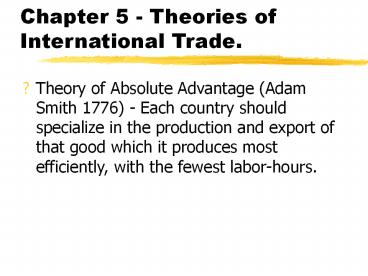Chapter 5 - Theories of International Trade. - PowerPoint PPT Presentation
Title:
Chapter 5 - Theories of International Trade.
Description:
... of that good which it produces most efficiently, with the fewest labor-hours. ... Theory of comparative advantage (David Ricardo 1819) - Even if one country was ... – PowerPoint PPT presentation
Number of Views:859
Avg rating:3.0/5.0
Title: Chapter 5 - Theories of International Trade.
1
Chapter 5 - Theories of International Trade.
- Theory of Absolute Advantage (Adam Smith 1776) -
Each country should specialize in the production
and export of that good which it produces most
efficiently, with the fewest labor-hours.
2
Theory of comparative advantage (David Ricardo
1819).
- Theory of comparative advantage (David Ricardo
1819) - Even if one country was most efficient in
the production of two products, it must be
relatively more efficient in the production of
one good. It should then specialize in the
production and exportation of that good in
exchange for the importation of the other.
3
Classical trade theory.
- Division of labor.
- Comparative advantage.
- Gains from trade.
4
Theory of factor proportions.
- A country that is relatively labor (capital)
abundant should specialize in the production and
export of that product which is relatively labor
(capital) intensive.
5
Other theories.
- Leontief Paradox - the U.S. was exporting more
labor intensive products than it was importing -
Measurement error, domestic equivalents, skilled
and unskilled labor. - Overlaping product ranges theory - marketers seek
similar markets. - Product life cycle theory - as the product
matures it becomes more labor intensive and the
comparative advantage shifts to different
countries.
6
Competitive advantage of nations (Michael
Porter).
- A nations competitiveness depends on the
capacity of its industry to innovate and upgrade.
Companies gain competitive advantage because of
pressure and challenge. They benefit from
having strong domestic rivals, aggressive
home-based suppliers and demanding local
customers. - Differences in national values, culture, economic
structures, institutions, and histories all
contribute to competitive success.
7
Competitive advantage of nations (Michael
Porter).
- Factor conditions - Ability to innovate, upgrade,
and deploy its factors. - Demand conditions - highly competitive and
demanding local markets. - Related and supporting industries - close working
relationships, proximity, and timeliness. - Firm, strategy, structure and rivalry -
appropriate and flexible conditions for the
situation.
8
Reasons for Trade Barriers
- Protection of an infant industry.
- Protection of the home market
- Foreign Exchange Requirements.
- Capital accumulation.
- Maintenance of Standard of living and real wages
- Conservation of Natural Resources.
9
Reasons for Trade Barriers (Contd.).
- Industrialization of a Developing Nation.
- Maintenance of employment and reduction of
unemployment. - National Defense
- Increase of business size.
- Self-reliance
- Retaliation, bargaining, balance of trade etc.
10
In Most Cases Protectionism results in
- Consumers paying a higher cost
- Industries getting stagnant and inefficient
- Lower quality goods for higher prices.
- Inflation.
- Lower standard of living.
- Retaliation by trading partners.































